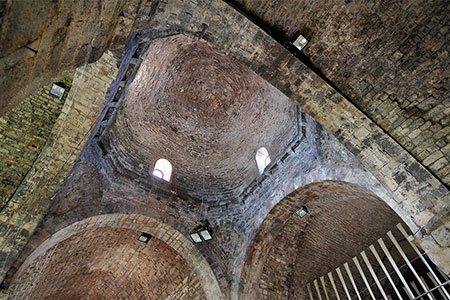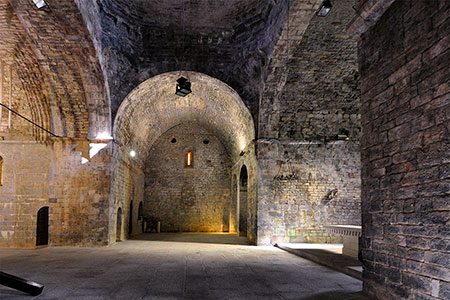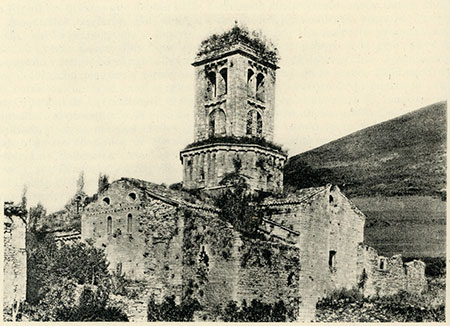The origin of this monastery can be traced back to an old church dedicated to Saint Peter that had been consecrated in November 904, at which time it was endowed with several rights and properties. In the middle of the 10th century, Count Wilfred II of Besalú decided to establish a monastery on the site of that church, which he had previously taken possession of. To this end, the count obtained from King Louis IV of France (920-954) a precept confirming the properties of the church, while at the same time establishing that the new monastery would follow the Rule of Saint Benedict.
Under the protection of the counts, the monastery grew in importance and property. In 1017, Pope Benedict VIII issued a bull confirming its properties and reaffirming its independence. A new population began to gather around it, which meant that at the beginning of the 11th century, a church (this one dedicated to Santa Maria) was built as a parish church, leaving the church of Sant Pere for the use of the monastic community. The 11th century was marked by a period of certain disorder; everything suggests that for a short period, Sant Pere de Camprodon was linked to the nearby monastery of Sant Joan de les Abadesses, in fact the abbot Andreu was abbot of both houses in 1077.
This situation led Bernard II of Besalú in 1078 to promote the union of Sant Pere de Camprodon with the abbey of Saint-Pierre de Moissac, in Languedoc, and indirectly to the congregation of Cluny, in fact this union was part of the process of reorganisation of other monasteries in the county (Santa Maria de Ripoll, Sant Esteve de Banyoles or Sant Pere de Besalú). Submission to this abbey lasted until 1461. The 12th century brought a period of recovery, with the acquisition of new properties and even the reconstruction of the church, which was consecrated in 1169, and the construction of the cloister. With prosperity came disagreements with Moissac, which continued over the years.
At the time of the separation from Moissac, Camprodon's situation was not an enviable one: it had suffered earthquakes in 1428 that had destroyed the buildings and could not be repaired. In 1470 it was sacked by the French, who took the chest of Saint Patllari (Palladius of Embrun), which was later returned and is still preserved in the church of Santa Maria. Community life was also very relaxed, with monks who even lived outside the monastery. In 1592 the monasteries of Santa Maria de Ridaura and Sant Joan les Fonts, also in full decline, were joined to it. That same year it became part of the Claustral Tarraconense Congregation.
At the end of the 17th century, the place was occupied again by the French, who used the church as a barracks. A new occupation took place again in 1794. The disentailment put a definitive end to monastic life. In 1835, the few monks who still occupied it had to leave. In 1859 a community of nuns arrived, but only for a short time. The 20th century saw the restoration of the church, which was re-consecrated in 1933. It is the only surviving part of the former Benedictine house.
- ABADAL I DE VINYALS, Ramon d' (2007). Catalunya Carolíngia. Vol. II. Els diplomes carolingis a Catalunya. 1. Barcelona: I. E. Catalans
- BARRAQUER I ROVIRALTA, Gaietà (1906). Las casas de religiosos en Cataluña durante el primer tercio del siglo XIX. Vol. 1. Barcelona: F. J. Altés
- COSTA I BADIA, Xavier (2019). Paisatges monàstics. El monacat alt-medieval als comtats catalans (segles IX-X). Tesi doctoral. Universitat de Barcelona
- GROS I PUJOL, Miquel S. (1995). Sant Pere de Camprodon: un monestir de comtat de Besalú. Art i cultura als monestirs del Ripollès. Barcelona: Pub. Abadia de Montserrat
- MERINO, Antolín (1819). España Sagrada. Vol. 43. Madrid: Collado
- MIRET I SANS, Joaquín (1898). Relaciones entre los monasterios de Camprodón y Moissac. Barcelona: L'Avenç
- MONER, José; GALÍ, Francisco de A. (1879). Historia de Camprodon. Barcelona: P. Casanovas
- MONSALVATJE Y FOSSAS, Francisco (1895). Monasterios del antiguo condado de Besalú. Noticias históricas Vol. VI. Olot: J. Bonet
- PLADEVALL, Antoni (1987). Catalunya romànica. Vol. X. El Ripollès. Barcelona: Enciclopèdia Catalana
- PUIG I CADAFALCH, J. (1918). Arquitectura romànica a Catalunya. Vol. 3. Barcelona: I. Estudis Catalans
- SOLER I MARTIN, Joan (1991). Història de Sant Patllari, patró de Camprodon. Camprodon. Consell Parroquial
- VILLANUEVA, Jaime (1851). Viage literario a las iglesias de España. Vol. XV. Madrid: R. A. de la Historia





















